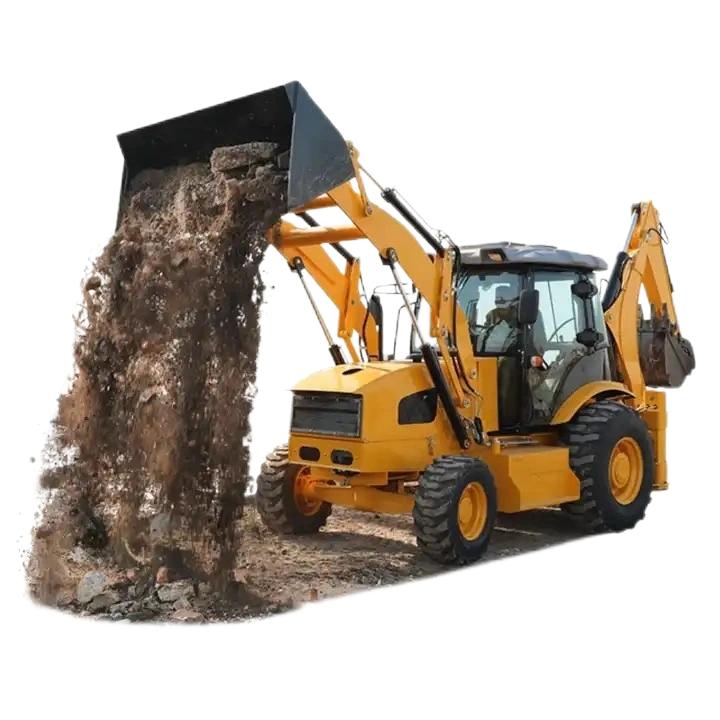Loader: The "Versatile Tool" in the Engineering Field, a Powerful Assistant for Efficient Operations
——Technology Innovation and Market Insights of Loaders in 2025

As the core equipment in fields such as earthwork construction and logistics transportation, loaders, with their characteristics of high efficiency, flexibility, and multi-functionality, continuously drive the engineering industry towards intelligentization and green development. The following comprehensively analyzes the value and prospects of loaders from aspects such as technical principles, core advantages, application scenarios, and future trends.
I. Technical Principles: The Underlying Support for Efficient Operations
Loaders transmit the engine power to the drive axle through a torque converter and combine with the hydraulic system to achieve precise lifting, tilting, and unloading of the bucket. The working device is composed of a bucket, a boom, connecting rods, etc., which are hinged together. The hydraulic system controls the actions through oil pressure to ensure the stable operation of the bucket in complex working conditions. For example, the one-time insertion scooping method is suitable for loose materials, while the composite scooping method improves the efficiency of heavy-load operations.
Core Component Advantages:
Engine: Powered by diesel or new energy, with a power range covering from 74 kW to over 515 kW, meeting the needs of projects of different scales.
Transmission System: The hydro-mechanical transmission combines smoothness with power output. The wheeled design improves maneuverability, while the crawler design enhances adaptability to complex terrains.
Intelligent Upgrade: 5G + Internet of Things technology enables remote monitoring and fault warning. The unmanned driving function is gradually being implemented in scenarios such as ports and mines.
II. Core Advantages: The "All-Rounder" in Engineering Scenarios
High-Efficiency Operations
The bucket capacity of loaders ranges from 0.3 m³ to 18 m³, and the load capacity can reach up to 18.41 t. Combined with the composite action mode, the daily operation efficiency is 30% higher than that of traditional equipment. For example, in port logistics, its fast loading and unloading capabilities can shorten the container transfer cycle.
Multi-Functional Expansion
By replacing attachments such as buckets and breakers, loaders can complete various tasks such as excavation, dozing, and leveling, adapting to multiple fields such as construction, mining, and agriculture.
Reliability and Safety
Adopting high-strength frames and hydraulic sealing technology, along with a 360° surround + radar safety system, effectively avoids visual blind spots and collision risks.
III. Application Scenarios: Wide Coverage from Construction Sites to Mines
Construction: Clearing foundation pits and transporting building materials to facilitate the efficient construction of high-rise buildings.
Mining: In harsh environments such as plateaus and tunnels, electric loaders have become the preferred choice due to their low noise and zero emissions.
Port Logistics: Automating container loading and unloading to improve port throughput efficiency.
Agriculture: Precise sowing and fertilizer transportation to promote agricultural modernization.
IV. Future Trends: Electric and Intelligent Driving Change
New Energy Transformation
By 2025, the penetration rate of electric loaders in scenarios such as steel mills and power plants will exceed 60%, and hydrogen fuel models will gradually be put into operation, reducing energy consumption costs by over 40%.
Intelligent Upgrade
Equipped with high-performance domain controllers and AI algorithms, loaders can achieve autonomous path planning, fault diagnosis, and remote maintenance, reducing labor costs by 35%.
Segmented Market Specialization
Small loaders (<3 t) focus on urban greening and municipal engineering, while large models (>10 t) are deeply involved in mines and large-scale infrastructure projects.
V. Safety and Maintenance: Ensuring Long-Term Value
Operation Specifications: Regularly check the sealing of the hydraulic system and braking performance, avoid overloading and sharp turns.
Maintenance Costs: Adopting a split bucket tooth design, only the tooth tips need to be replaced after wear, reducing maintenance frequency.
Conclusion
As the "versatile tool" in the engineering field, loaders are continuously revitalizing through technological innovation and in-depth exploration of scenarios. Whether it is the construction party pursuing efficient operations or mining enterprises focusing on environmental protection, choosing a suitable loader solution will significantly improve engineering efficiency and investment returns.





